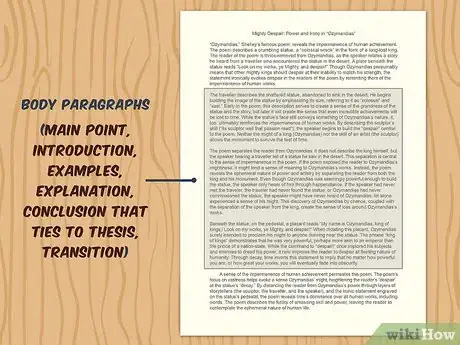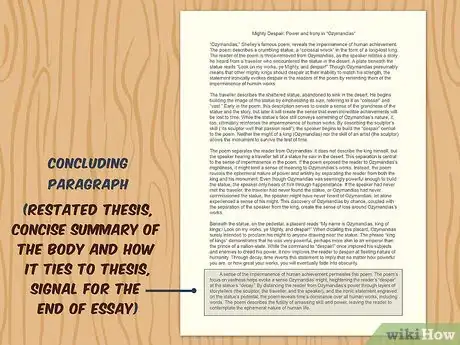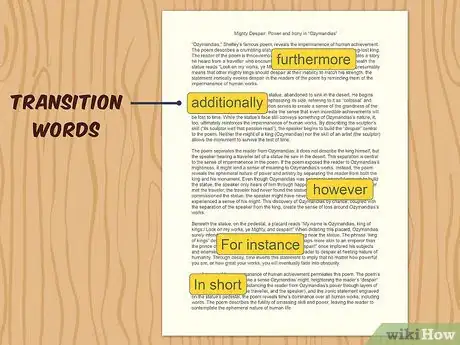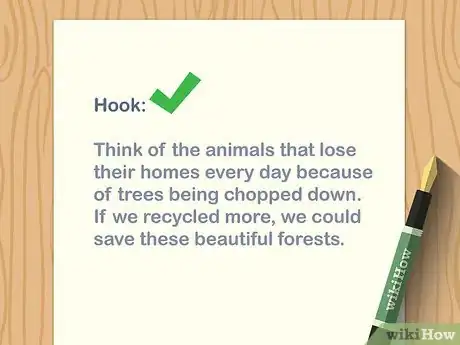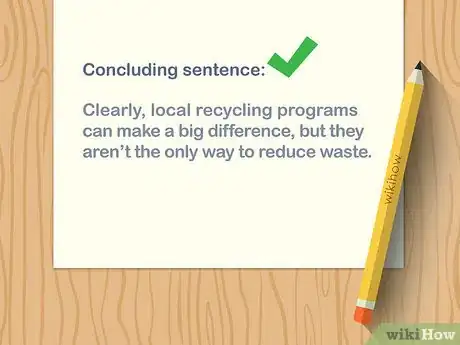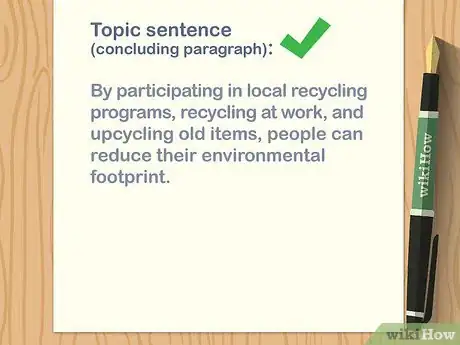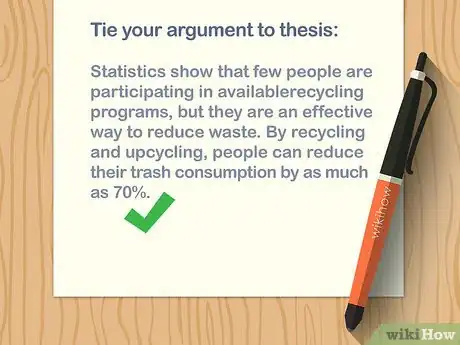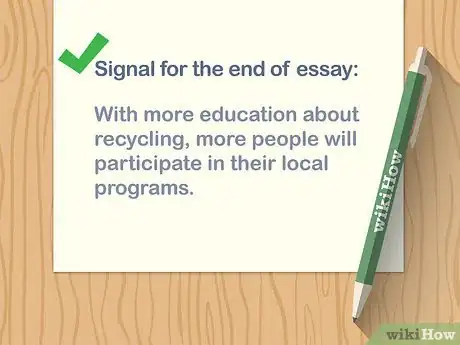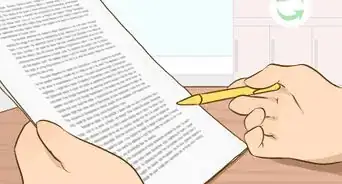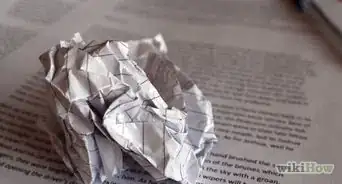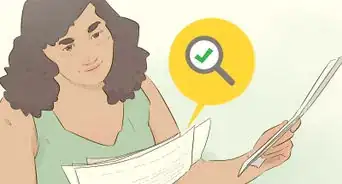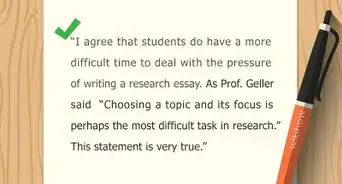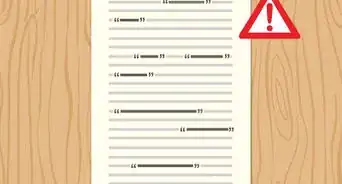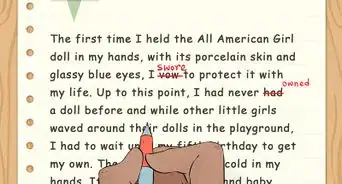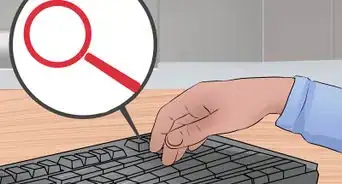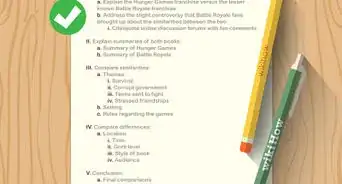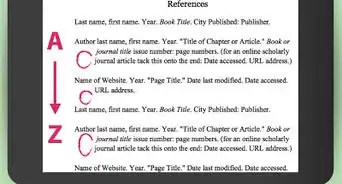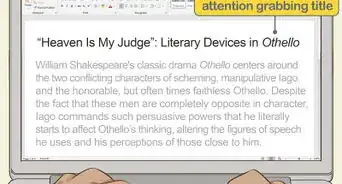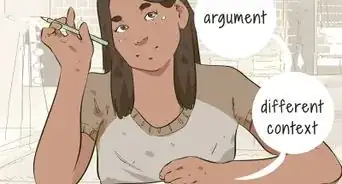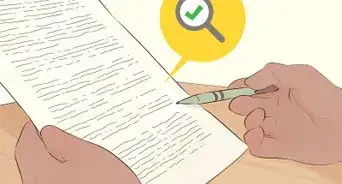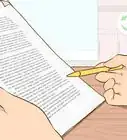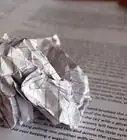This article was co-authored by Christopher Taylor, PhD and by wikiHow staff writer, Danielle Blinka, MA, MPA. Christopher Taylor is an Adjunct Assistant Professor of English at Austin Community College in Texas. He received his PhD in English Literature and Medieval Studies from the University of Texas at Austin in 2014.
There are 10 references cited in this article, which can be found at the bottom of the page.
This article has been viewed 169,191 times.
Writing an essay can be challenging, especially if you're not sure how to structure your paragraphs. If you’re struggling to organize your essay, you’re in luck! Putting your paragraphs in order may become easier after you understand their purpose. Additionally, knowing what to include in your introduction, body, and conclusion paragraphs will help you more easily get your writing assignment finished.
Steps
Essay Template and Sample Essay
Putting Your Paragraphs in Order
-
1Start your essay with an introductory paragraph. Your introduction should tell your reader what your essay is going to be about. The first 3 sentences will give an overview of the subject. After you introduce your topic or problem, you’ll end your introduction with a 1 sentence thesis that will lay out your argument or stance on the topic.[1]
- A basic introduction will be about 3-4 sentences long.
-
2Include at least 3 body paragraphs to explain your ideas. Your body paragraphs are where you’ll explain your argument or stance on your topic. First, introduce the main point of this paragraph. Then, give your evidence or support for the points you’re making. Next, explain your evidence and how it supports your ideas. Finally, provide a transition to your next paragraph.[2]
- Body paragraphs will make up the bulk of your essay. At a minimum, a body paragraph needs to be 4 sentences long. However, a good body paragraph in a short essay will be at least 6-8 sentences long.
Advertisement -
3End with a concluding paragraph. Your conclusion provides a brief summary of your ideas so that the reader can reflect on them. Help the reader understand what you want them to take from this essay. For example, you might give them a call to action or ask them to rethink their position on your topic.[3]
- A good conclusion for a short essay will be 3-4 sentences long.
-
4Use transition words to move smoothly from paragraph to paragraph. Your reader will recognize that your paragraph breaks mean that you are going on to a new point. However, transitions can help you make that move more easily. You can use transitions to show how your ideas are either related to each other or opposed to each other.[4]
- For example, let’s say you’re writing an essay about recycling. Your first point might be about the value of local recycling programs, while your second point might be about the importance of encouraging recycling at work or school. A good transition between these two points might be “furthermore” or “additionally.”
- If your third point is about how upcycling might be the best way to reuse old items, a good transition word might be “however” or “on the other hand.” This is because upcycling involves reusing items rather than recycling them, so it's a little bit different. You want your reader to recognize that you're talking about something that slightly contrasts with your original two points.
Structuring Your Introduction
-
1Open your essay with a “hook” that engages your reader’s interest. Your first sentence needs to make your reader want to continue reading. This is often difficult, so you might want to write this sentence last. Here are some common ways to hook your reader:[5]
- Provide a quote: “According to Neil LaBute, ‘We live in a disposable society.’”
- Include statistics: “The EPA reports that only 34 percent of waste created by Americans is recycled every year.”
- Give a rhetorical question: “If you could change your habits to save the planet, would you do it?”
-
2Explain your topic and why it’s important in 2 sentences. Write 2 general statements about your topic, narrowing down to your thesis. Give your readers a general idea about what you will write about, including any important background information.[6]
- Here’s an example: “Recycling offers a way to reduce waste and reuse old items, but many people don’t bother recycling their old goods. Unless people change their ways, landfills will continue to grow as more generations discard their trash.”
-
3Present your argument or stance in your thesis statement. The last sentence in your introduction is your thesis statement, which is like a road map for your essay. Your thesis should include your stance on the topic and the points you will article. Later, you will develop thesis points in each of your paragraphs.[7]
- Here’s how a basic thesis about recycling might look: "To reduce the amount of trash in landfills, people must participate in local recycling programs, start recycling at school or work, and upcycle old items whenever they can."
- If you’re writing an argument or persuasive essay, your thesis might look like this: “Although recycling may take more effort, recycling and upcycling are both valuable ways to prevent expanding landfills.”
Crafting Good Body Paragraphs
-
1Begin each body paragraph when you have a new idea to introduce. The "body" paragraphs are the paragraphs between your introduction and conclusion. Paragraphs begin with a new idea, which should be explained in the topic sentence. There is no standard size for paragraphs, but they should have at least 4 sentences.[8]
- A good body paragraph in a short essay typically has 6-8 sentences. If you’re not sure how many sentences your paragraphs should include, talk to your instructor.
- Write a new paragraph for each of your main ideas. Packing too much information into one paragraph can make it confusing.
-
2Write a clear topic sentence to introduce your main point. Begin your paragraph by clearly stating its topic. The topic sentence should state one idea or point, as clearly as possible. The rest of the paragraph will expand on the idea in this sentence.[9]
- If you begin your essay by writing an outline, include your topic sentence for each paragraph in your outline.
- You might write, “Local recycling programs are a valuable way to reduce waste, but only if people use them.”
-
3Provide your evidence to back up the point you’re making. Your evidence might be a quote, statistic, or example that backs up your idea. Choose evidence that’s appropriate for your essay assignment. If you’re not sure what to use, talk to your instructor and review your assignment sheet.[10]
- Your evidence might come from books, journal articles, websites, or other authoritative sources.
- The word evidence might make you think of data or experts. However, some essays will include only your ideas, depending on the assignment. In this case, you might be allowed to take evidence from your observations and experiences, but only if your assignment specifically allows this type of evidence.
- You could write, “According to Mayor Anderson’s office, only 23 percent of local households participate in the city’s recycling program.”
-
4Analyze your evidence in 1-2 sentences to connect it back to your ideas. Explain the evidence in your own words, then tell the reader how it supports your main idea for this paragraph. Help the reader understand how this information supports your thesis.[11]
- In some cases, you may offer more than one piece of evidence in the same paragraph. Make sure you provide a 1 to 2 sentence explanation for each piece of evidence.
- For instance, “Residents who are using the recycling program aren’t contributing as much trash to local landfills, so they’re helping keep the community clean. On the other hand, most households don’t recycle, so the program isn’t as effective as it could be.”
-
5Conclude the paragraph. Use the final sentence of the paragraph to link your paragraph to the main topic of your essay, or to introduce an idea that you will explore in your next paragraph.[12]
- For instance, you could write, “Clearly, local recycling programs can make a big difference, but they aren’t the only way to reduce waste.”
Arranging Your Conclusion
-
1Restate your thesis in the opening sentence of your conclusion. Begin your conclusion by reminding your reader of your main points. This helps your reader recall what you set out to prove in your essay.[13]
- You could write, “By participating in local recycling programs, recycling at work, and upcycling old items, people can reduce their environmental footprint.”
-
2Summarize how your arguments support your thesis in 1-2 sentences. Briefly explain the key information your provided in your essay, as well as how it proves your ideas. Convince the reader that you proved your point.[14]
- As an example, “Statistics show that few people are participating in available recycling programs, but they are an effective way to reduce waste. By recycling and upcycling, people can reduce their trash consumption by as much as 70%.”
-
3End by answering the question “so what.” This helps your reader know what you want them to take from your essay. It provides relevance to your essay, making the reader appreciate your ideas more. Here are some great ways to end your essay:[15]
- Give your readers a call to action. For example, “To save the planet, everyone needs to recycle."
- Offer a solution to the problem you presented. For instance, "With more education about recycling, more people will participate in their local programs."
- Point to the next question that needs to be answered. You might write, "To get more people to recycle, researchers need to determine the reasons why they don't."
- Provide a valuable insight about your topic. As an example, "If everyone recycled, landfills might become a thing of the past."
Community Q&A
-
QuestionHow should I conclude my essay?
 Community AnswerYou could provide an interesting fact to get readers to want to find out more about the topic. Also, make sure to restate the three main ideas you used in your essay. You want to tie the topic together, so make sure you make it interesting.
Community AnswerYou could provide an interesting fact to get readers to want to find out more about the topic. Also, make sure to restate the three main ideas you used in your essay. You want to tie the topic together, so make sure you make it interesting. -
QuestionHow can I link paragraphs?
 Community AnswerUse transition words at the beginning of each paragraph to give your essay a good flow. Also, make sure to hook the reader by asking a question, giving the reader something to imagine or citing an interesting fact.
Community AnswerUse transition words at the beginning of each paragraph to give your essay a good flow. Also, make sure to hook the reader by asking a question, giving the reader something to imagine or citing an interesting fact.
Warnings
- If you copy someone else’s writing or ideas, it’s called plagiarism. Don’t ever plagiarize, as this is a serious offense. Not only will you get in trouble if you plagiarize, you probably won’t receive credit for the assignment.⧼thumbs_response⧽
References
- ↑ https://writingcenter.unc.edu/tips-and-tools/introductions/
- ↑ https://www.student.unsw.edu.au/writing-your-essay
- ↑ https://writingcenter.unc.edu/tips-and-tools/conclusions/
- ↑ https://www.plainlanguage.gov/guidelines/organize/use-transition-words/
- ↑ https://www.esu.edu/writing-studio/guides/hook.cfm
- ↑ https://www.deakin.edu.au/__data/assets/pdf_file/0011/810596/Guide-to-essay-paragraph-structure_Deakin-Study-Support.pdf
- ↑ https://wts.indiana.edu/writing-guides/how-to-write-a-thesis-statement.html
- ↑ https://libguides.newcastle.edu.au/writing-paragraphs/structure
- ↑ https://libguides.newcastle.edu.au/writing-paragraphs/structure
- ↑ https://lsa.umich.edu/sweetland/undergraduates/writing-guides/how-do-i-write-an-intro--conclusion----body-paragraph.html
- ↑ https://lsa.umich.edu/sweetland/undergraduates/writing-guides/how-do-i-write-an-intro--conclusion----body-paragraph.html
- ↑ https://libguides.newcastle.edu.au/writing-paragraphs/structure
- ↑ https://www.umgc.edu/current-students/learning-resources/writing-center/writing-resources/parts-of-an-essay/essay-conclusions
- ↑ https://www.umgc.edu/current-students/learning-resources/writing-center/writing-resources/parts-of-an-essay/essay-conclusions
- ↑ https://writingcenter.unc.edu/tips-and-tools/conclusions/


